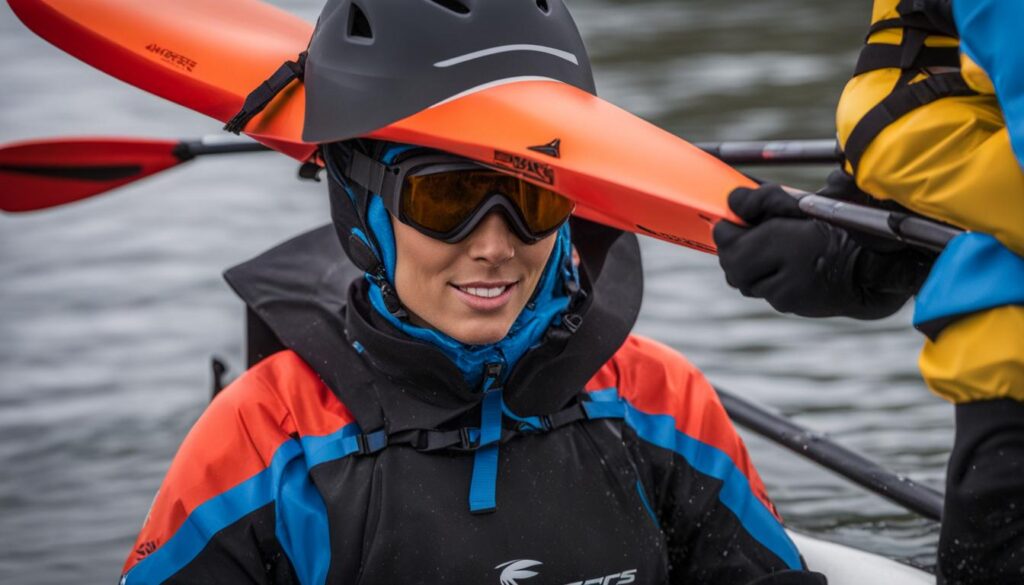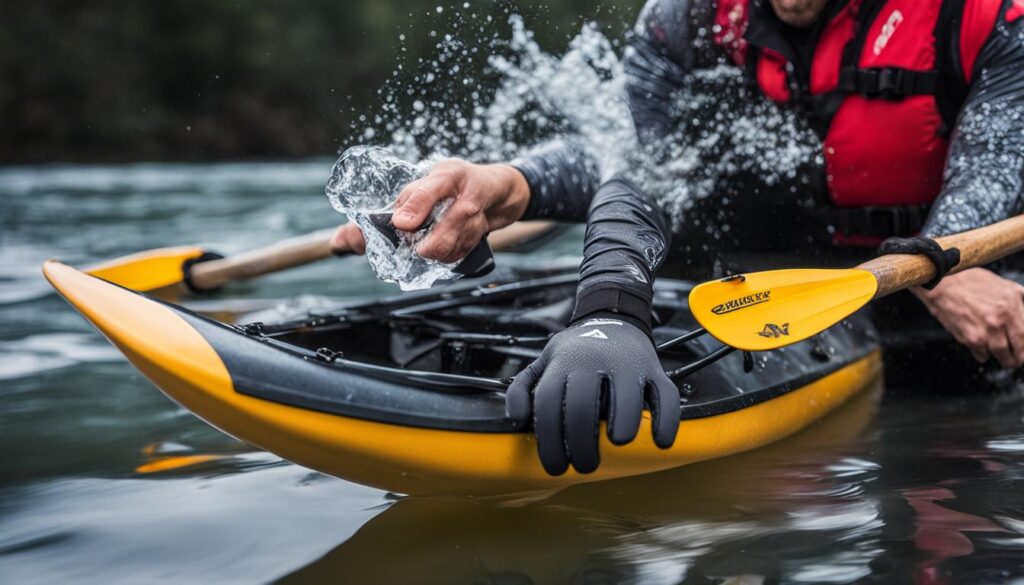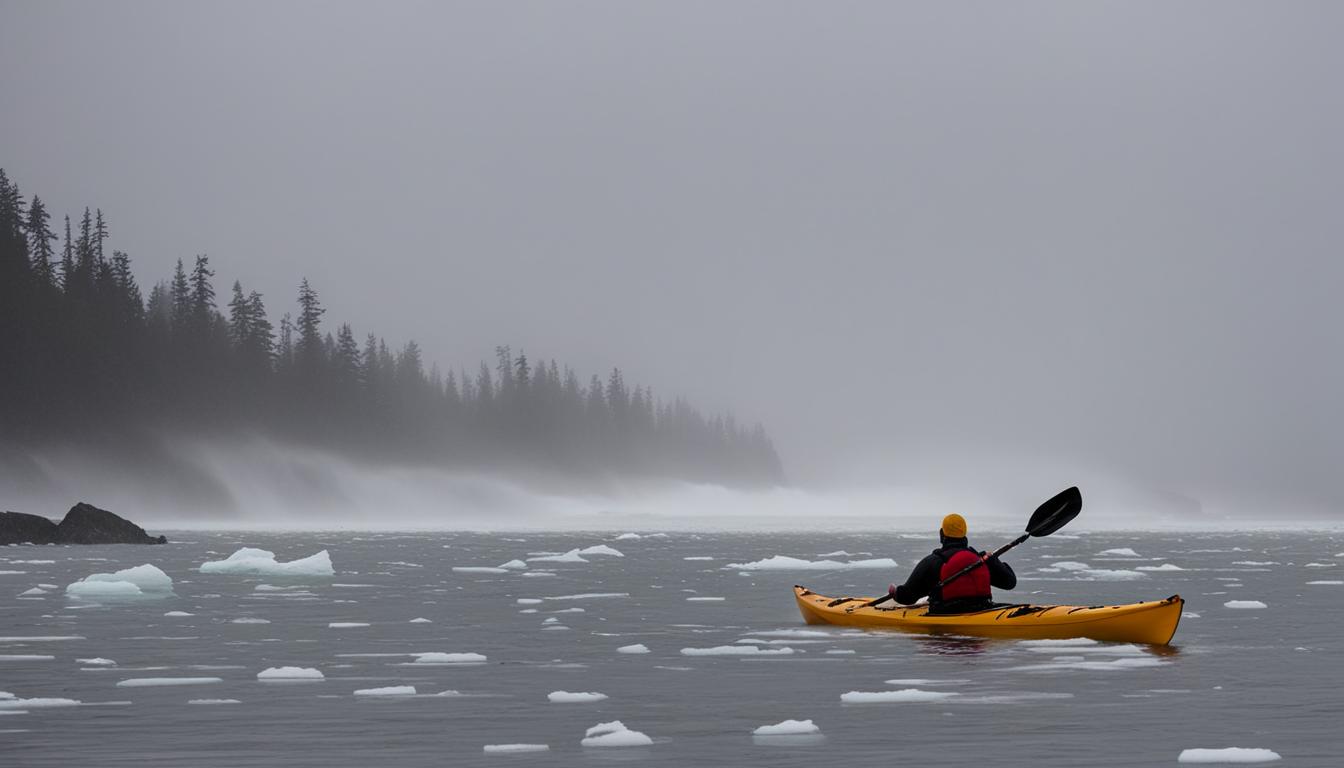Are you an adventurous kayaker looking for a thrilling challenge? If so, cold water sea kayaking might be just the activity for you. Exploring the open waters in cold conditions can provide a unique and exhilarating experience. However, it’s crucial to understand the risks and take the necessary precautions to ensure your safety and enjoyment.
When kayaking in cold water, immersion can lead to cold shock, hypothermia, and even death. To prevent these dangers, it’s essential to wear appropriate clothing and gear, as well as follow cold water safety guidelines. By doing so, you can embark on an exciting winter sea kayaking adventure while keeping yourself protected.
Key Takeaways:
- Prepare for cold water paddling with the right clothing and gear.
- Understand the risks of hypothermia and the impact of water temperature.
- Layer your clothing for optimal warmth and protection.
- Consider wetsuits, neoprene paddlewear, and drysuits for insulation.
- Keep your hands, head, and feet warm with appropriate gear.
Understanding Water Temperature and Hypothermia Risk
When it comes to cold water sea kayaking, understanding water temperature is crucial for ensuring your safety. The risk of hypothermia increases as the water temperature drops, so it’s important to be aware of the conditions in the area where you plan to paddle. Water temperatures between 55-59°F pose a moderate risk, while temperatures below 45°F present an extreme risk. Being prepared and knowledgeable about the potential risks can help you make informed decisions and take necessary precautions.
Wearing appropriate clothing is essential for reducing the risk of hypothermia in cold water. A wetsuit or drysuit is recommended, as they provide insulation and protect your body from the cold water. A wetsuit, made of neoprene, traps a thin layer of water against your skin, which is then warmed by your body heat. It offers insulation in water temperatures above 50°F. Drysuits, on the other hand, provide complete waterproof protection and are ideal for extremely cold water conditions.
By being aware of water temperature and wearing the right gear, you can minimize the risk of hypothermia while enjoying the thrills of cold water sea kayaking. Remember to always prioritize your safety and follow best practices to make the most of your kayaking experience.
Table: Hypothermia Risk Levels Based on Water Temperature
| Water Temperature (°F) | Risk Level |
|---|---|
| Below 45 | Extreme |
| 45-54 | High |
| 55-59 | Moderate |
| 60-69 | Low |
| 70 and above | Minimal |
Dressing for Cold Water Kayaking: Layering and Gear
When it comes to cold water kayaking, dressing appropriately is key to staying warm and comfortable on the water. Layering your clothing is essential to regulate your body temperature and protect against the cold. Here’s a guide to dressing for cold water kayaking:
Base Layer:
Your base layer should consist of wicking synthetic fabrics like polypropylene. These materials draw sweat and moisture away from your skin, keeping you dry and preventing chills. Avoid cotton as it retains moisture and can make you feel colder.
Insulating Mid-Layers:
Adding insulating mid-layers such as fleece or wool provides an extra layer of warmth. These materials trap heat and keep you cozy, even in chilly conditions.
Outer Layer:
Your outer layer should be waterproof and windproof to protect against the elements. Look for jackets and pants made from technical fabrics that offer both breathability and weather resistance. This will help keep you dry and shielded from the wind.
Wetsuits and Drysuits:
For additional insulation and protection from the water, consider wearing a wetsuit or a drysuit. Wetsuits are made of neoprene and trap a thin layer of water against your skin, which is then warmed by your body heat. Drysuits, while more expensive, provide complete waterproof protection and are ideal for extremely cold water conditions.

Remember to always dress in layers, as it allows you to adjust your clothing according to your comfort level. Opt for materials that are quick-drying and breathable to prevent overheating and ensure maximum flexibility while paddling.
By dressing appropriately and wearing the right gear, you can enjoy a safe and enjoyable cold water kayaking experience, even in chilly conditions.
Wetsuits, Neoprene Paddlewear, and Drysuits
When it comes to gearing up for cold water kayaking, choosing the right attire is essential to stay warm, comfortable, and safe on the water. Wetsuits, neoprene paddlewear, and drysuits are popular options that offer varying degrees of insulation and protection.
Wetsuits are made of neoprene and provide insulation by trapping a thin layer of water against the skin. This layer of water is warmed by your body heat, keeping you cozy in chilly conditions. Wetsuits are suitable for water temperatures above 50°F and offer flexibility and mobility while paddling. They are a great option for moderate cold water kayaking.
For those looking for more flexibility in their gear, neoprene paddlewear is worth considering. Brands like NRS Hydroskin offer a range of neoprene layers that can be worn alone or layered for added warmth. Neoprene paddlewear provides insulation and protection, making it a versatile choice for changing weather conditions.
For the ultimate protection against cold water, drysuits are the way to go. Drysuits are fully waterproof and provide complete protection from water intrusion. They are recommended for extremely cold water conditions, where thermal insulation and staying dry are critical. While drysuits may be more expensive, they offer the highest level of warmth and comfort in cold water kayaking.
Comparison of Wetsuits, Neoprene Paddlewear, and Drysuits
| Wetsuits | Neoprene Paddlewear | Drysuits | |
|---|---|---|---|
| Insulation | Traps a thin layer of water against the skin | Insulating neoprene layers | Fully waterproof and insulated |
| Flexibility | Flexible and allows for ease of movement | Flexible and can be layered for added warmth | Slightly less flexible due to the waterproof layer |
| Protection | Provides insulation and some water resistance | Offers insulation and protection from water | Complete protection from water intrusion |
| Recommended Water Temperature | Above 50°F | Varies depending on layers and thickness | Extremely cold water conditions |
When selecting your cold water kayaking gear, consider the water temperature, your personal comfort level, and the duration of your paddling adventure. It’s important to choose the gear that will keep you warm, dry, and comfortable throughout your time on the water.
Cold Water Kayaking Essentials: Keeping Your Hands and Head Warm
When venturing out for cold water kayaking, it’s crucial to protect your extremities from the frigid temperatures. This means keeping your hands and head warm throughout your paddling adventure. Here are some essential gear options to consider:
Hand Protection: Cold Water Kayaking Gloves
Investing in a pair of high-quality cold water kayaking gloves is paramount to ensure your hands stay warm and functional. Neoprene gloves are a popular choice, providing insulation and protection against the cold water. Look for gloves that offer a snug fit and have reinforced palms for a better grip on your paddle. These gloves are designed to keep your hands warm even when they come into contact with the water, allowing you to fully enjoy your kayaking experience.
Headwear for Kayaking: Neoprene Hoods
Neoprene hoods are specifically designed to keep your head warm and protected during cold water kayaking. They provide insulation and cover your ears, preventing cold water from entering and causing discomfort or even vertigo. Neoprene hoods come in different thicknesses to suit varying water temperatures. They are an essential piece of gear to retain body heat and ensure your safety and comfort while kayaking in chilly conditions.
In addition to these key items, it’s important to remember that layering is crucial to staying warm during cold water kayaking. Layering your clothing with appropriate base layers, insulating mid-layers, and a waterproof outer layer will help regulate your body temperature and protect you from the elements. Always check the weather and water conditions before heading out, and make sure your gear is in good condition.

| Glove Type | Features |
|---|---|
| Neoprene Gloves | Insulating, water-resistant, reinforced palms |
| 5-Finger Gloves | Increased dexterity, better paddle grip |
| Mittens | Warmer, less dexterity |
“Investing in high-quality cold water kayaking gloves and a neoprene hood is essential to keep your hands and head warm during your paddling adventures in chilly conditions.”
– Cold Water Paddler
Protecting Your Feet: Neoprene Booties
When it comes to cold water kayaking, protecting your feet is crucial. Neoprene booties are specifically designed to keep your feet warm and protected during your paddling adventures. These booties offer insulation and prevent water from entering, ensuring that your feet stay dry, comfortable, and ready for action.
Neoprene booties come in various thicknesses and styles, allowing you to choose the right option for the temperature conditions you’ll be facing. For colder temperatures, over-the-ankle booties are recommended as they provide extra coverage and insulation. These booties are built to withstand the demands of cold water kayaking, offering durability and flexibility for a comfortable fit.
With their excellent insulation properties, neoprene booties keep your feet warm by trapping a thin layer of water against your skin, which is then warmed by your body heat. This eliminates the discomfort of cold feet and ensures that you can fully enjoy your paddling experience without discomfort or distraction.
| Benefits of Neoprene Booties | Drawbacks of Neoprene Booties |
|---|---|
|
|
Investing in a pair of neoprene booties is a wise choice for any cold water kayaker. They provide the necessary protection and insulation to keep your feet warm, ensuring that you can paddle comfortably for extended periods. Remember to choose booties that fit well and allow for proper circulation to avoid discomfort or numbness. With neoprene booties on your feet, you’ll be ready to conquer any cold water kayaking adventure.
What to Consider When Choosing Neoprene Booties
When selecting neoprene booties for cold water kayaking, there are a few key factors to consider:
- Thickness: Choose the appropriate thickness based on the water temperature.
- Fit: Ensure a snug fit to prevent water from seeping in while allowing for proper circulation.
- Style: Consider the height and coverage offered by the booties to suit your needs.
- Quality: Look for booties made from high-quality neoprene materials for durability and longevity.
- Traction: Check for a good grip on the sole to maintain balance on slippery surfaces.
By taking these factors into account, you can find the perfect pair of neoprene booties that will keep your feet warm, protected, and ready to tackle the challenges of cold water kayaking.
Cold Water Gear Considerations
When it comes to cold water kayaking, having the right gear can make all the difference in ensuring a safe and enjoyable experience. In addition to dressing appropriately for the weather and wearing the right clothing layers, there are a few additional items that you should consider adding to your cold water kayaking gear collection.
Paddle Drip Rings
One useful accessory to consider is paddle drip rings. These simple devices attach to your paddle shaft and help prevent water from running down the shaft and onto your lap, keeping you dry and comfortable during your paddling adventures.
Regular Gear Maintenance
Regularly checking and maintaining your cold water gear is essential to ensure its effectiveness. Make sure to inspect your gear before each paddle, looking for any signs of wear or damage. This includes checking for holes or tears in wetsuits or drysuits, ensuring zippers are functioning properly, and inspecting booties and gloves for any damage. By taking the time to regularly maintain your gear, you can help prolong its lifespan and ensure it continues to provide the necessary protection in cold water conditions.
Practice Capsize and Re-entry Techniques
No one plans on capsizing, but accidents can happen. Being prepared for unexpected situations is crucial for your safety. Take the time to practice capsize and re-entry techniques in a safe environment, such as a swimming pool or calm body of water. These practices can help you become familiar with the process of getting back into your kayak after a capsize, increasing your confidence and preparedness in case of an emergency.
| Gear Consideration | Description |
|---|---|
| Paddle Drip Rings | Paddle drip rings attach to the paddle shaft and prevent water from running down onto your lap. |
| Regular Gear Maintenance | Regularly check and maintain your gear to ensure its effectiveness and prolong its lifespan. |
| Practice Capsize and Re-entry Techniques | Practice these techniques in a safe environment to increase your preparedness for unexpected situations. |
Conclusion
When it comes to cold water paddling, safety is paramount. By following the best practices for kayaking in cold conditions, you can enjoy your adventure while staying safe. Understanding the risks associated with cold water immersion and taking necessary precautions is crucial.
One of the most important aspects of cold water paddling safety is dressing appropriately. Layering your clothing and wearing gear like wetsuits, neoprene paddlewear, or drysuits will help keep you warm and protected from the elements. Remember to also protect your hands and head with neoprene gloves and hoods, and wear neoprene booties to keep your feet insulated.
Aside from proper clothing and gear, it’s essential to be familiar with additional cold water gear considerations. Paddle drip rings, regular gear maintenance, and practicing capsizing and re-entry techniques will further ensure your safety on the water.
With the right preparation and knowledge, you can confidently enjoy cold water kayaking. So grab your gear, stay warm, and have a fantastic time exploring the chilly waters while keeping your safety a top priority!
FAQ
What are the risks of paddling in cold water?
Paddling in cold water poses risks of cold shock, hypothermia, and even death. It is important to be aware of these dangers and take necessary precautions.
How does water temperature affect the risk of hypothermia?
The risk of hypothermia increases as the water temperature drops. Water temperatures between 55-59°F pose a moderate risk, while temperatures below 45°F present an extreme risk. Knowing the water temperature is crucial for assessing the potential danger.
What clothing should I wear for cold water kayaking?
Layering is key when dressing for cold water kayaking. Start with a wicking synthetic base layer, add insulating mid-layers like fleece or wool, and top it off with a waterproof and windproof outer layer. Wetsuits, neoprene paddlewear, and drysuits are also popular options depending on the water temperature.
What are the different options for wetsuits and drysuits?
Wetsuits are neoprene garments that provide insulation in water temperatures above 50°F. Neoprene paddlewear offers flexibility and can be layered, while drysuits provide complete waterproof protection for extremely cold water conditions.
How can I keep my hands and head warm while kayaking in cold water?
Neoprene gloves provide insulation and protection for the hands. Neoprene hoods keep the head warm and prevent cold water from entering the ears. Proper headwear, like neoprene hats or balaclavas, help retain body heat and prevent heat loss through the head.
What should I wear on my feet for cold water kayaking?
Neoprene booties are essential for keeping your feet warm and protected. Over-the-ankle booties are recommended for colder temperatures, offering insulation and preventing water from entering.
Are there any other gear considerations for cold water kayaking?
Yes, paddle drip rings can help keep you dry by preventing water from running down the shaft. Regularly checking and maintaining your cold water gear is important for its effectiveness. Swim-testing your gear before each paddle is also recommended. Additionally, practicing capsizing and re-entry techniques in a safe environment prepares you for unexpected situations.





